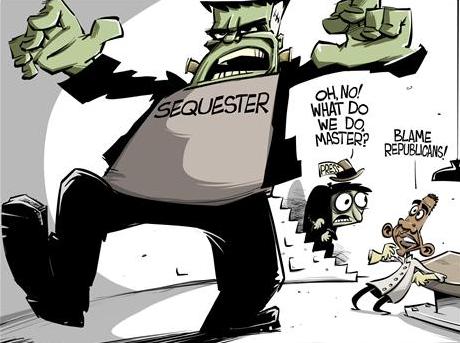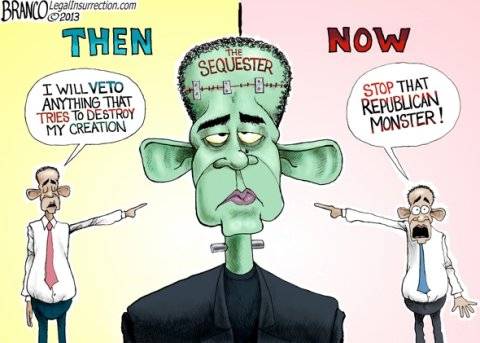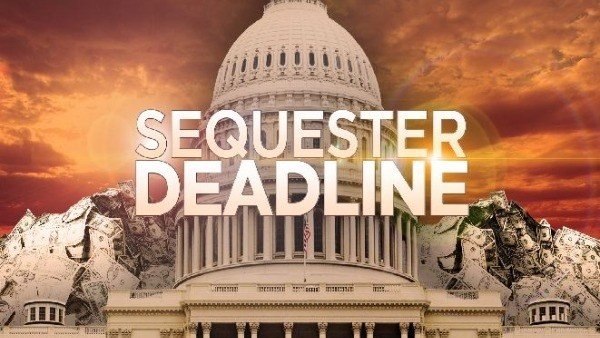Thursday, February 28, 2013
Obama’s Sequester Monster is Coming!
 Is this just another one of Obama’s Scary Spending Cuts Movies? Will Obama’s Sequester Monster finally arrive at midnight when all those Spending Cuts are supposed to kick in? For weeks elected officials have been trying to keep a straight face as they issued the direst warnings imaginable about the impending $85 billion in spending cuts that will devour both the needy and the American way of life in a GOP-powered rampage across the countryside, beginning this Friday.
Is this just another one of Obama’s Scary Spending Cuts Movies? Will Obama’s Sequester Monster finally arrive at midnight when all those Spending Cuts are supposed to kick in? For weeks elected officials have been trying to keep a straight face as they issued the direst warnings imaginable about the impending $85 billion in spending cuts that will devour both the needy and the American way of life in a GOP-powered rampage across the countryside, beginning this Friday.
Obama already released hordes of illegal immigrants convicted of felonies in our courts from custody across the country (and that went double for you, Arizona) on Monday supposedly to save the cost of housing and feeding of all those spics at the same time the White House was making its case that impending budget cuts would harm efforts to protect the border and enforce federal immigration laws. Obama called it “Sequestration Liberation.”
Remember: These so-called “cuts” are only to the projected increase in spending, not to what we’re currently spending.
So, why is the sequester being hyped like it’s the poster boy for a creature double-feature? John Keller at CBS Boston says it’s because the shallow partisans who populate Washington are doing what they do best – playing to their bases, and ideological posturing – instead of what they do worst: negotiating, compromising and governing.
Now Obama’s “Organizing for America Super PAC says “Prepare yourself for job layoffs, reduced access to early education, slower emergency response, slashed health care, and more people living on the street” and .“Let’s all chip in $25 or more to Obama’s grassroots organization that will get the job done.”
Obama’s Threatened Sequester Cuts
 The Office of Management and Budget (OMB) now calculates that sequestration will require an annual reduction of roughly 5% for non-defense programs and roughly 8% for defense programs. However, given that these cuts must be achieved over only seven months instead of 12, the effective percentage reductions will be approximately 9% for non-defense programs and 13% for defense programs. These large and arbitrary cuts will have severe impacts across the government.
The Office of Management and Budget (OMB) now calculates that sequestration will require an annual reduction of roughly 5% for non-defense programs and roughly 8% for defense programs. However, given that these cuts must be achieved over only seven months instead of 12, the effective percentage reductions will be approximately 9% for non-defense programs and 13% for defense programs. These large and arbitrary cuts will have severe impacts across the government.
- CUTS TO EDUCATION: Our ability to teach our kids the skills they’ll need for the jobs of the future would be put at risk. 70,000 young children would lose access to Head Start, 10,000 teacher jobs would be put at risk, and funding for up to 7,200 special education teachers, aides, and staff could be cut.
- CUTS TO SMALL BUSINESS: Small businesses create two-thirds of all new jobs in America. Instead of helping small businesses expand and hire, the automatic cuts would reduce loan guarantees to small businesses by up to approximately $900 million.
- CUTS TO FOOD SAFETY: Outbreaks of food-borne illness are a serious threat to families and public health. If sequestration takes effect, up to 2,100 fewer food inspections could occur, putting families at risk and costing billions in lost food production.
- CUTS TO RESEARCH AND INNOVATION: To compete for the jobs of the future and ensure that the next breakthroughs to find cures for critical diseases are developed right here in America, we need to continue to lead the world in research and innovation. Most Americans with chronic diseases don’t have a day to lose, but under sequestration progress towards cures would be delayed and several thousand researchers could lose their jobs. Up to 12,000 scientists and students would also be impacted.
- CUTS TO MENTAL HEALTH: If sequestration takes effect, up to 373,000 seriously mentally ill adults and seriously emotionally disturbed children could go untreated. This would likely lead to increased hospitalizations, involvement in the criminal justice system, and homelessness for these individuals.
- FBI AND OTHER LAW ENFORCEMENT: The FBI and other law enforcement entities would see a reduction in capacity equivalent to more than 1,000 Federal agents. This loss of agents would significantly impact our ability to combat violent crime, pursue financial crimes, secure our borders, and protect national security.
- CUSTOMS AND BORDER PATROL – U.S. Customs and Border Protection (CBP) would not be able to maintain current staffing levels of border patrol agents and CBP officers as mandated by Congress. CBP would have to reduce its work hours by the equivalent of over 5,000 border patrol agents and the equivalent of over 2,750 CBP officers. Funding and staffing reductions would increase wait times at airports, weaken security between land ports of entry, limit CBP’s ability to collect for revenue owed to the Federal government, and slow screening and entry for those traveling into the United States. At the major gateway airports, average wait times could increase by 30-50 percent. At the nation’s busiest airports, like Newark, JFK, LAX, and Chicago O’Hare, peak wait times could grow to over four hours or more. On the southwest land border, our biggest ports of entry in California and Texas could face wait times of 5 hours or more during peak holiday weekends and travel periods. And at our seaports, delays in container examinations could increase from 2-3 days to 4-5 days, resulting in congestion at terminals, increased transaction costs to the trade community, and reduced availability of consumer goods and raw materials critical to our economy.
- AVIATION SAFETY – The Federal Aviation Administration (FAA) would be forced to undergo a funding cut of more than $600 million. This action would force the FAA to undergo an immediate retrenchment of core functions by reducing operating costs and eliminating or reducing services to various segments of the flying community. A vast majority of FAA’s nearly 47,000 employees would be furloughed for approximately one day per pay period, with a maximum of two days per pay period. The furlough of a large number of air traffic controllers and technicians would require a reduction in air traffic to a level that could be safely managed by the remaining staff, resulting in slower air traffic in major cities, as well as delays and disruptions across the country during the critical summer travel season.
- AVIATION SECURITY – The Transportation Security Administration (TSA) would reduce its front-line workforce, which would substantially increase passenger wait times at airport security checkpoints. TSA would need to initiate a hiring freeze for all transportation security officer positions in March, eliminate overtime, and furlough its 50,000 officers for up to seven days.
- EMERGENCY RESPONDERS – FEMA would need to reduce funding for State and local grants that support firefighter positions and State and local emergency management personnel, hampering our ability to respond to natural disasters like Hurricane Sandy and other emergencies.
- NIH RESEARCH – The National Institutes of Health (NIH) would be forced to delay or halt vital scientific projects and make hundreds of fewer research awards. Since each research award supports up to seven research positions, several thousand personnel could lose their jobs. Many projects would be difficult to pursue at reduced levels and would need to be cancelled, putting prior year investments at risk. These cuts would delay progress on the prevention of debilitating chronic conditions that are costly to society and delay development of more effective treatments for common and rare diseases affecting millions of Americans.
- NSF RESEARCH – The National Science Foundation (NSF) would issue nearly 1,000 fewer research grants and awards, impacting an estimated 12,000 scientists and students and curtailing critical scientific research.
- NEW DRUG APPROVALS – The FDA’s Center for Drug Evaluation and Research (CDER) would face delays in translating new science and technology into regulatory policy and decision-making, resulting in delays in new drug approvals. The FDA would likely also need to reduce operational support for meeting review performance goals, such as the recently negotiated user fee goals on new innovative prescription drugs and medical devices.
- SMALL BUSINESS ASSISTANCE – Small Business Administration (SBA) loan guarantees would be cut by up to approximately $900 million, constraining financing needed by small businesses to maintain and expand their operations and create jobs.
- ECONOMIC DEVELOPMENT – The Economic Development Administration’s (EDA) ability to leverage private sector resources to support projects that spur local job creation would be restricted, likely resulting in more than 1,000 fewer jobs created than expected and leaving approximately $50 million in private sector investment untapped. Oil and gas permitting – Development of oil and gas on Federal lands and waters would slow down, due to cuts in programs at the Department of the Interior (DOI) and other agencies that plan for new projects, conduct environmental reviews, issue permits and inspect operations. Leasing of new Federal lands for future development would also be delayed, with fewer resources available for agencies to prepare for and conduct lease sales.
- FOOD SAFETY – The Food and Drug Administration (FDA) could conduct 2,100 fewer inspections at domestic and foreign facilities that manufacture food products while USDA’s Food Safety and Inspection Service (FSIS) may have to furlough all employees for approximately two weeks. These reductions could increase the number and severity of safety incidents, and the public could suffer more foodborne illness, such as the recent salmonella in peanut butter outbreak and the E. coli illnesses linked to organic spinach, as well as cost the food and agriculture sector millions of dollars in lost production volume.
- VETERANS SERVICES – Although the Department of Veterans Affairs is exempt from sequestration, the Department of Labor’s Veterans Transition Assistance Program, which serves over 150,000 veterans a year, would have to reduce operations – leaving thousands of transitioning veterans unserved as they move from active duty to civilian life. The Jobs for Veterans State Grants Program would also experience cuts, translating into a reduction in the capacity to serve tens of thousands of veterans in their efforts to find civilian employment.
- NATIONAL PARKS – Many of the 398 national parks across the country would be partially or fully closed, with shortened operating hours, closed facilities, reduced maintenance, and cuts to visitor services. These closures will hurt the many small businesses and regional economies that depend on nearby national parks to attract visitors to their region.
- TITLE I EDUCATION FUNDS – Title I education funds would be eliminated for more than 2,700 schools, cutting support for nearly 1.2 million disadvantaged students. This funding reduction would put the jobs of approximately 10,000 teachers and aides at risk. Students would lose access to individual instruction, after-school programs, and other interventions that help close achievement gaps.
- SPECIAL EDUCATION (IDEA) – Cuts to special education funding would eliminate Federal support for more than 7,200 teachers, aides, and other staff who provide essential instruction and support to preschool and school-aged students with disabilities.HEAD START – Head Start and Early Head Start services would be eliminated for approximately 70,000 children, reducing access to critical early education. Community and faith based organizations, small businesses, local governments, and school systems would have to lay off over 14,000 teachers, teacher assistants, and other staff.
- SOCIAL SECURITY APPLICANT AND BENEFICIARY SERVICES – The Social Security Administration (SSA) would be forced to curtail service to the public and reduce program oversight efforts designed to make sure benefits are paid accurately and to the right people. Potential effects on SSA operations could include a reduction in service hours to the public, and a substantial growth in the backlog of Social Security disability claims.
- SENIOR MEALS – Federally-assisted programs like Meals on Wheels would be able to serve four million fewer meals to seniors. These meals contribute to the overall health and well-being of participating seniors, including those with chronic illnesses that are affected by diet, such as diabetes and heart disease, and frail seniors who are homebound. The meals can account for 50 percent or more of daily food for the majority of participants.
- NUTRITION ASSISTANCE FOR WOMEN, INFANTS AND CHILDREN – Approximately 600,000 women and children would be dropped from the Department of Agriculture’s Special Supplemental Nutrition Program for Women, Infants, and Children (WIC) from March through September. At least 1,600 State and local jobs could be lost as a result.
- CHILD CARE– Cuts to the Department of Health and Human Services’ Child Care and Development Fund would leave 30,000 low-income children without child care subsidies, denying them access to child development programs and ending a crucial work support for many families.
- RENTAL ASSISTANCE – The Department of Housing and Urban Development’s (HUD) Housing Choice Voucher program, which provides rental assistance to very low-income families, would face a significant reduction in funding, which would place about 125,000 families at immediate risk of losing their permanent housing.
- EMERGENCY UNEMPLOYMENT COMPENSATION – People receiving Emergency Unemployment Compensation benefits would see their benefits cut by nearly 11 percent. Affected long-term unemployed individuals would lose an average of more than $450 in benefits that they and their families count on while they search for another job. Smaller unemployment checks will also have a negative impact on the economy as a whole. Economists have estimated that every dollar in unemployment benefits generates $2 in economic activity.
- HOMELESSNESS PROGRAMS – More than 100,000 formerly homeless people, including veterans, would be removed from their current housing and emergency shelter programs, putting them at risk of returning to the streets.
- MENTAL HEALTH AND SUBSTANCE ABUSE SERVICES – Cuts to the Mental Health Block Grant program would result in over 373,000 seriously mentally ill adults and seriously emotionally disturbed children not receiving needed mental health services. This cut would likely lead to increased hospitalizations, involvement in the criminal justice system, and homelessness for these individuals. In addition, close to 8,900 homeless persons with serious mental illness would not get the vital outreach, treatment, housing, and support they need through the Projects for Assistance in Transition from Homelessness (PATH) program.
- AIDS AND HIV TREATMENT AND PREVENTION – Cuts to the AIDS Drug Assistance Program could result in 7,400 fewer patients having access to life saving HIV medications. And approximately 424,000 fewer HIV tests could be conducted by Centers for Disease Control (CDC) State grantees, which could result in increased future HIV transmissions, deaths from HIV, and costs in health care.
- TRIBAL SERVICES – The Indian Health Service and Tribal hospitals and clinics would be forced to provide 3,000 fewer inpatient admissions and 804,000 fewer outpatient visits, undermining needed health care in Tribal communities.
The Blower says that even if some of the above items seem to duplicate others, it is only your imagination, since you can be sure your government would not waste be your hard-earned money on duplicate programs.
BREAKING NEWS: Not to worry, Everybody— “Obama will be coming to save the day” when he plans to meet Friday with the top four congressional leaders where Obama will straighten all of this out. Doesn’t this remind you of something?
More Political Perspective
 Now Dewey from Detroit sends us this little story to help Republicans explain the scale of sequester cuts to their constituents and hopefully help them put things in perspective:
Now Dewey from Detroit sends us this little story to help Republicans explain the scale of sequester cuts to their constituents and hopefully help them put things in perspective:
George Finds Out He’s getting a 2% pay “cut”
George was expecting to get a $10/week raise, because he’s gotten a $10/week raise every year since he went to work for the Ace Car Company. (See “What does $40 a month mean to you?” from our last manufactured fiscal crisis.)
Then George’s boss tells him that – due to budgetary constraints imposed on Ace by corporate – he’s forced to cut everybody’s raise by 2% (as agreed to by George’s UAW union president in the last round of contract talks – when nobody figured the sky would actually fall). So now, instead of the $10/week he was counting on, George will only be getting a $9.80/ week raise this year.
On hearing this awful news George immediately shifted into crisis mode: he pulled his son out of day care forcing his wife to quit her job to stay home with the kid, canceled the family trip to Disneyworld which they could no longer afford since his wife wasn’t working, and sold his car and the house to save money. Then, having no reason or will to live, George quit his job, starting using drugs and alcohol and went on welfare.
The end.
Another Proud Sponsor and Avid Fan
Today’s edition is brought to you by a generous “in-kind” donation during our February fund-raising drive by Acme Temporary Personnel Agency, offering to supply cheap employees to government agencies during the sequester crisis.
SEQUESTER THREATS HOTLINE HOT LINE
e-mail your ingenious intimidation today.
Some bullying items in today’s Blower were sent in by our equally bullying subscribers.
Link of the Day
Traveling To Anywhere But There
![]() Note: We guarantee Blackberry subscribers who don’t go home and see links and pictures on their computers are not going to appreciate all of this good stuff today.
Note: We guarantee Blackberry subscribers who don’t go home and see links and pictures on their computers are not going to appreciate all of this good stuff today.
Current Whistleblower Policies and Disclaimers can be found here


